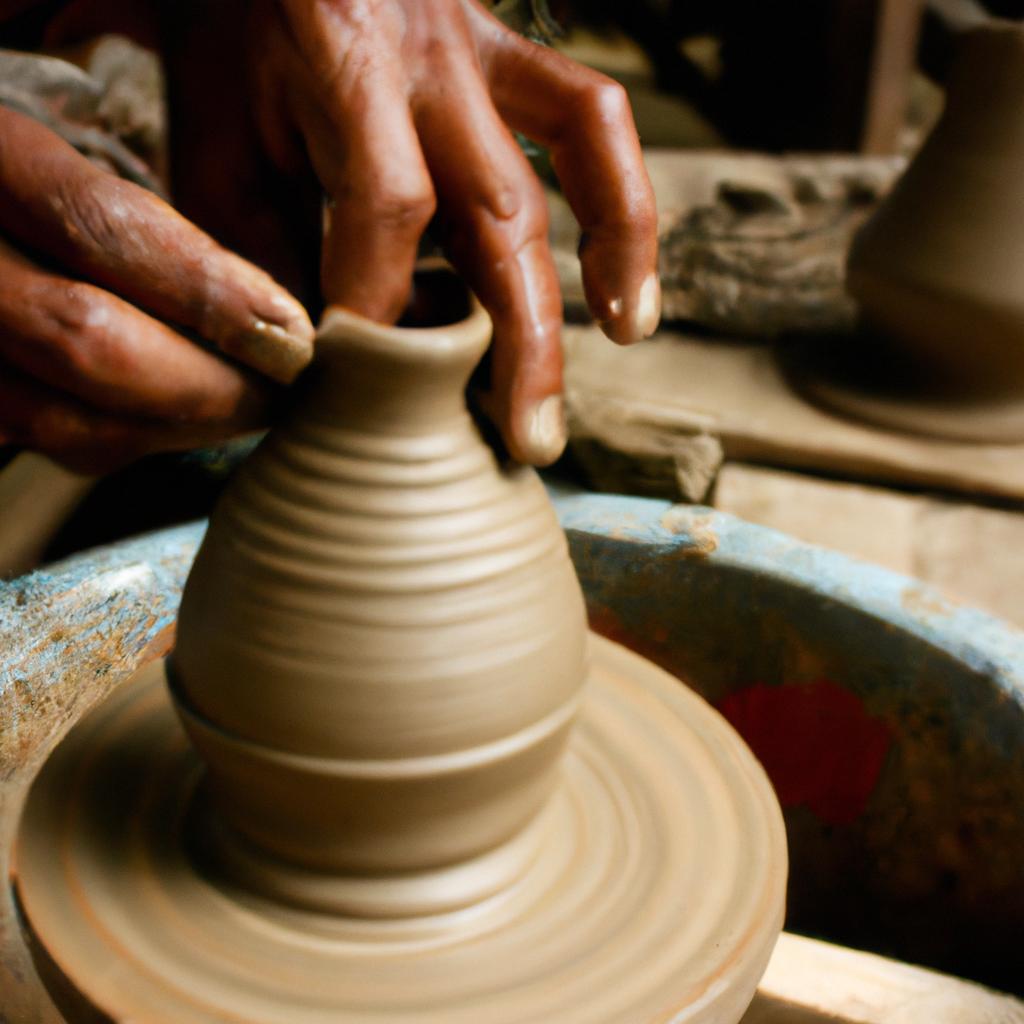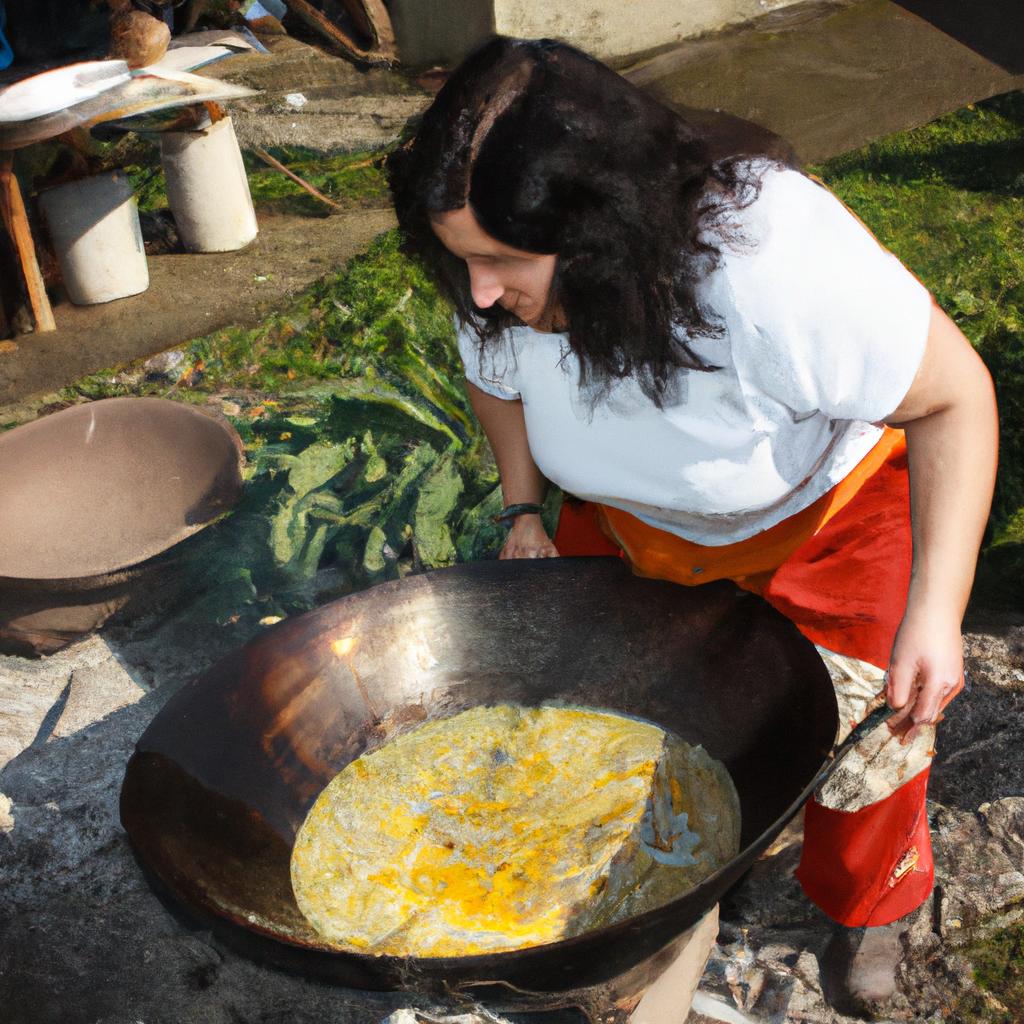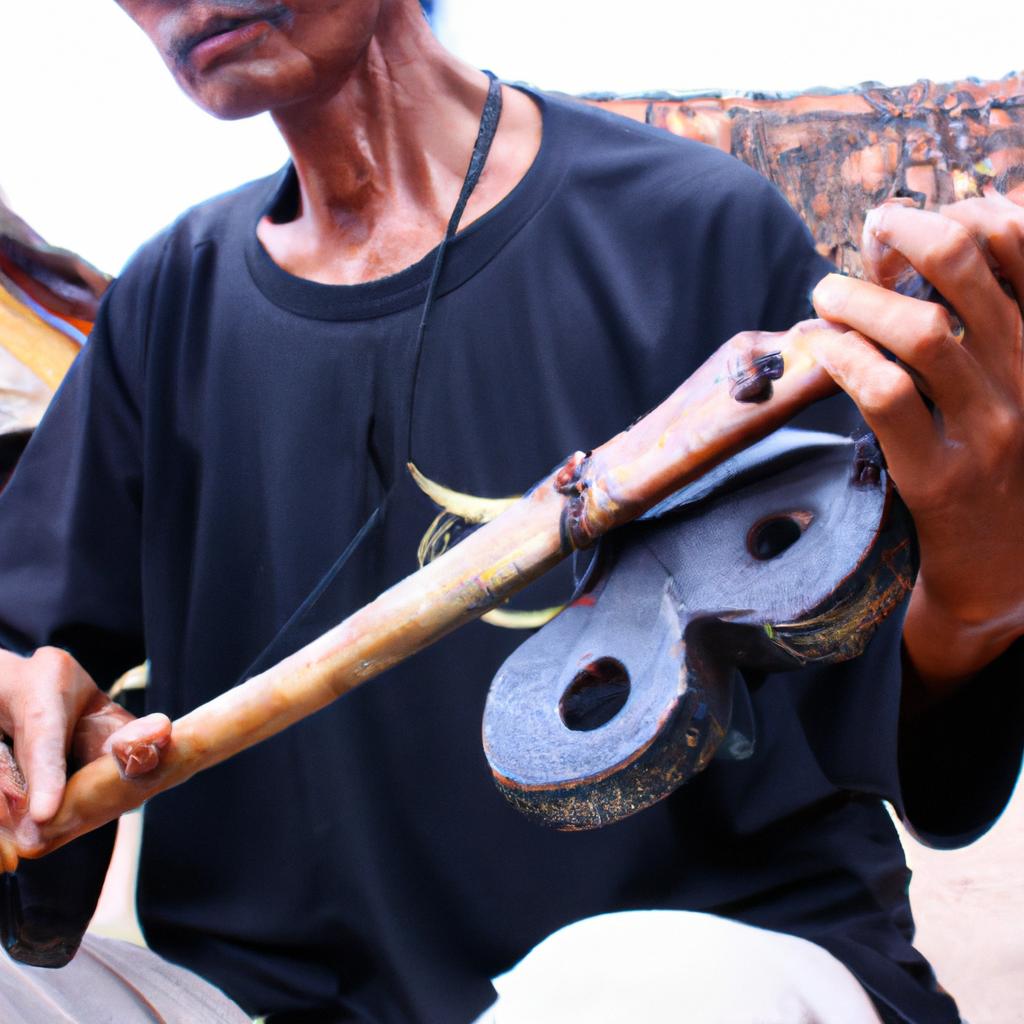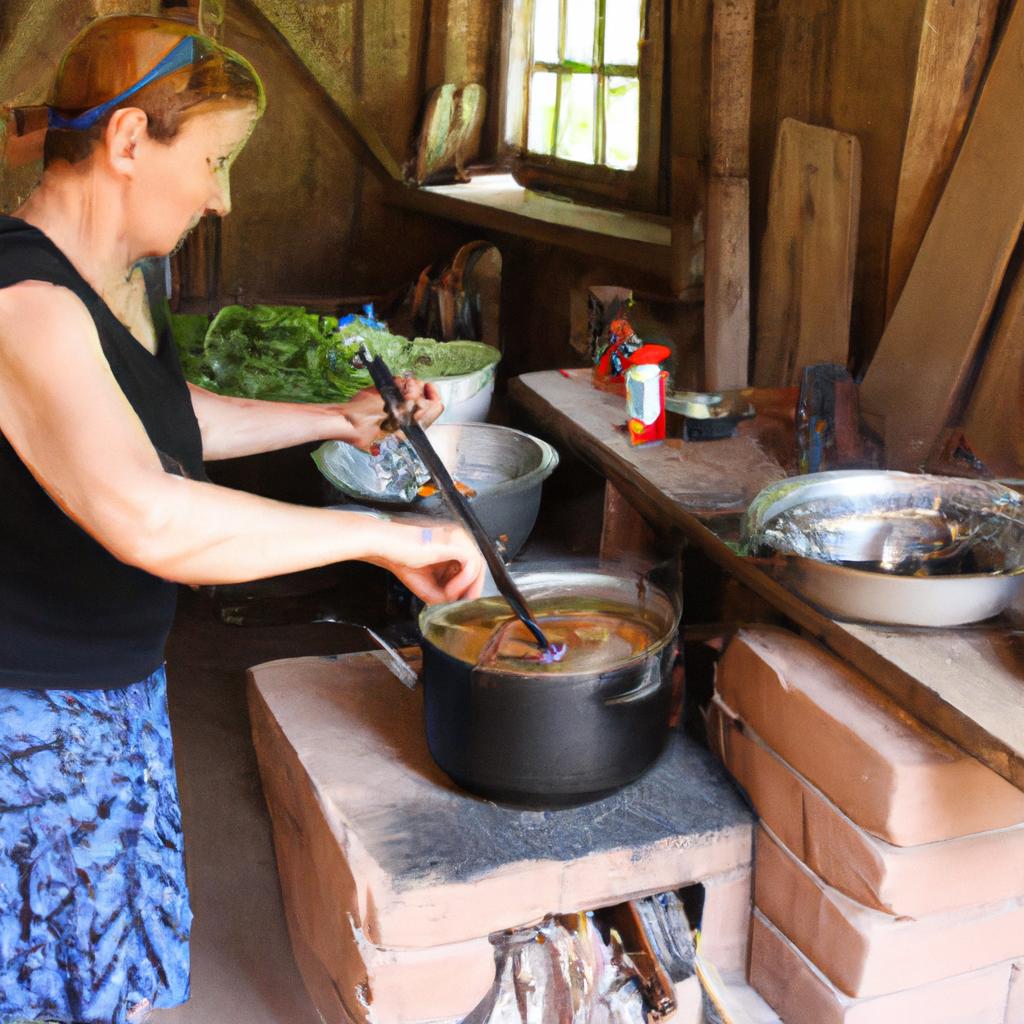Archaeological sites have long been regarded as important windows into the past, offering invaluable insights into ancient civilizations and their way of life. In recent years, these sites have also emerged as popular destinations for travelers seeking unique cultural experiences and immersive accommodations. One such destination that combines archaeology and rural accommodation in a captivating blend is Cangas de Onas, a small town nestled amidst the picturesque landscapes of northern Spain. This article explores the multifaceted appeal of archaeological sites in Cangas de Onas, highlighting how they provide not only a glimpse into history but also an opportunity for visitors to connect with local traditions and heritage.
To illustrate the allure of archaeological sites in Cangas de Onas, let us consider the hypothetical case study of Ana, a passionate traveler eager to delve into the region’s rich historical tapestry. Upon arriving at her chosen accommodation within close proximity to an ancient Roman settlement, Ana finds herself immersed in an environment steeped in antiquity. As she ventures through meticulously preserved ruins and artifacts dating back centuries, she cannot help but marvel at the intricate craftsmanship and ingenuity displayed by those who came before. Ana transcends mere observation; she becomes part of history itself, connecting deeply with a culture that once thrived on this land.
As Ana explores the archaeological site, she encounters knowledgeable local guides who provide fascinating insights into the daily lives of the ancient Romans who once inhabited the area. She learns about their customs, beliefs, and societal structures, gaining a deeper understanding of how they shaped the region’s history. Ana also has the opportunity to participate in interactive workshops where she can try her hand at ancient crafts or traditional cooking methods, allowing her to fully immerse herself in the culture and heritage of Cangas de Onas.
Beyond its historical significance, Cangas de Onas offers breathtaking natural beauty that further enhances the appeal of its archaeological sites. The town is surrounded by rolling hills, lush green valleys, and meandering rivers that create a stunning backdrop for these ancient ruins. Visitors like Ana can take leisurely walks along scenic trails that wind through the countryside, providing moments of tranquility and reflection amidst a landscape unchanged over centuries.
In addition to its cultural and natural allure, Cangas de Onas also boasts charming rural accommodations that seamlessly blend modern comfort with traditional aesthetics. Ana finds herself staying in a rustic farmhouse turned boutique hotel nestled amidst vineyards and olive groves. Each room is tastefully decorated with locally sourced materials and offers panoramic views of the surrounding countryside. This unique accommodation allows Ana to experience authentic rural life while enjoying luxurious amenities.
Overall, archaeological sites in Cangas de Onas offer visitors like Ana a multifaceted experience that goes beyond mere historical exploration. They serve as gateways into an ancient world, enabling travelers to connect with local traditions, immerse themselves in nature’s beauty, and enjoy unique accommodations that reflect the region’s rich heritage. Whether one seeks knowledge or seeks solace in nature’s embrace, Cangas de Onas proves to be an irresistible destination for those yearning for an extraordinary travel experience rooted in history and culture.
Historical Significance of Cangas de Onas
Historical Significance of Cangas de Onas
Cangas de Onas, a small town located in the region of Asturias, Spain, holds significant historical importance dating back to ancient times. One notable example is the discovery of an ancient Roman settlement within its vicinity, showcasing the rich cultural heritage present in this area. The archaeological findings at Cangas de Onas shed light on the past and provide valuable insights into the lives of those who once inhabited these lands.
The historical significance of Cangas de Onas can be understood through various aspects that have shaped its identity over time:
- Strategic Location: Situated along important trade routes during different periods in history, Cangas de Onas served as a crucial hub for commercial activities. Its proximity to rivers allowed for easy transportation of goods and facilitated connections with neighboring regions.
- Cultural Exchange: Due to its strategic location, Cangas de Onas became a melting pot where diverse cultures converged. This amalgamation resulted in a unique blend of customs and traditions that influenced the local way of life.
- Architectural Heritage: The architectural remains discovered in Cangas de Onas showcase remarkable craftsmanship from different eras. Structures such as temples, amphitheaters, and residential buildings reflect the changing architectural styles throughout history.
- Artifacts and Relics: Excavations conducted at archaeological sites within Cangas de Onas have yielded a plethora of artifacts and relics that provide tangible evidence of past civilizations’ existence. These objects range from pottery fragments and tools to intricate jewelry pieces, offering invaluable glimpses into daily life practices.
To better grasp the emotional connection one can establish with Cangas de Ona’s historical significance, consider the following bullet points:
- Immerse yourself in a journey spanning centuries when exploring this captivating town.
- Witness firsthand how human ingenuity has transcended time and left its mark on the landscape.
- Marvel at the architectural wonders that stand as a testament to human creativity and resilience.
- Discover artifacts that unveil stories of triumph, hardship, and everyday life in ancient times.
Additionally, here is a table highlighting some key archaeological sites found in Cangas de Onas:
| Archaeological Site | Period/Epoch | Noteworthy Finds |
|---|---|---|
| Roman Settlement | 1st – 3rd CE | Mosaic floors depicting mythological scenes |
| Medieval Castle Ruins | 12th – 14th | Defensive structures and remnants of medieval life |
| Prehistoric Cave Paintings | Paleolithic era | Vivid depictions of animals and early human activities |
| Neolithic Dolmen Burial Sites | Neolithic period | Megalithic tombs showcasing burial customs |
With its historical significance firmly established, this section paves the way for exploring the fascinating excavation discoveries made at archaeological sites within Cangas de Onas.
Excavation Discoveries at Archaeological Sites
Cangas de Onas, a small town nestled in the picturesque region of Asturias in northern Spain, holds significant historical importance. One noteworthy example is the discovery of an ancient Roman settlement that dates back to the 1st century BCE. This archaeological site offers valuable insights into the lives and culture of the Romans who once inhabited this area.
Excavations at the archaeological sites in Cangas de Onas have revealed fascinating artifacts and structures from different time periods. The remains of houses, courtyards, and public buildings unearthed here provide evidence of a well-organized community with advanced architectural techniques. Additionally, pottery fragments, tools, and coins found on-site shed light on the daily activities and trade practices of its inhabitants.
Visiting these archaeological sites not only allows us to marvel at their historical significance but also provides an opportunity for cultural enrichment. As we explore the ruins, we can imagine what life was like during various epochs—the bustling streets filled with merchants during Roman times or the tranquil countryside dwellings during medieval eras. Such immersive experiences help us connect with our past and foster a deeper understanding of human history.
To further engage visitors emotionally, let’s consider some key aspects that make visiting these archaeological sites truly captivating:
- Sense of wonder: Stepping foot onto hallowed ground where ancient civilizations thrived evokes a sense of awe and curiosity.
- Connection to ancestors: Exploring these remnants connects individuals to their ancestral roots, highlighting a shared heritage.
- Preservation efforts: Witnessing ongoing preservation work instills appreciation for those dedicated to safeguarding our collective history.
- Timelessness: Encountering timeless relics reminds us that while societies evolve over centuries, certain aspects remain constant.
Table: Key Artifacts Unearthed at Archaeological Sites in Cangas de Onas
| Artifact | Description | Historical Era |
|---|---|---|
| Roman coins | Currency used during the Roman occupation | 1st century BCE |
| Pottery fragments | Fragments of ceramic vessels from various periods | Various |
| Tools | Implements used in daily life | Various |
| Architectural ruins | Remains of houses and public buildings | Various |
In summary, the archaeological sites in Cangas de Onas hold immense historical significance. Through excavation discoveries, we gain valuable insights into past civilizations and their way of life. Visiting these sites not only allows us to marvel at their splendor but also fosters a deeper understanding of our shared cultural heritage.
Transitioning into the subsequent section about “Unique Features of Rural Accommodation in Cangas de Onas,” one can appreciate how this town’s rich history intertwines with its present-day offerings.
Unique Features of Rural Accommodation in Cangas de Onas
The excavation discoveries at archaeological sites in Cangas de Onas provide valuable insights into the region’s rich historical past. These findings offer a glimpse into the lives of ancient civilizations and shed light on their cultural practices, beliefs, and social structures. One notable example is the discovery of an intact Roman villa, which has provided archaeologists with a wealth of information about daily life during that time period.
Exploring these archaeological sites allows visitors to immerse themselves in history and experience firsthand the remnants of bygone eras. The rural accommodation options available in Cangas de Onas allow travelers to combine their cultural experiences with comfortable and authentic lodging. Here are some unique features of these accommodations:
-
Tranquil Setting: Nestled amidst picturesque landscapes, the rural accommodations offer a serene environment where guests can relax and unwind after a day of exploring archaeological sites.
-
Traditional Architecture: Many of these accommodations have been restored from traditional farmhouses or historic buildings, allowing guests to stay in rooms that showcase local architectural styles while still providing modern amenities.
-
Local Cuisine: Guests can savor delicious regional dishes made from locally sourced ingredients, offering a true taste of the area’s gastronomic heritage.
-
Cultural Activities: In addition to visiting archaeological sites, guests can participate in various cultural activities organized by the accommodation providers, such as guided tours to nearby landmarks or workshops showcasing local crafts and traditions.
By staying at one of these rural accommodations, visitors not only gain access to convenient lodging but also contribute to the preservation and sustainability efforts undertaken by local communities.
Moving forward, we will explore the cultural heritage of Cangas de Onas, delving deeper into its vibrant traditions and customs that continue to shape this captivating region today
Exploring the Cultural Heritage of Cangas de Onas
In the picturesque region of Cangas de Onas, rural accommodation offers a unique experience for travelers seeking to immerse themselves in the cultural heritage of this ancient land. One such example is the charming Casa del Río, nestled amidst rolling hills and overlooking a tranquil river. This restored farmhouse provides visitors with an authentic taste of traditional Asturian architecture while offering modern amenities for a comfortable stay.
One key aspect that sets rural accommodations apart in Cangas de Onas is their connection to nature. Surrounded by lush greenery and breathtaking landscapes, these establishments provide guests with an opportunity to disconnect from the hustle and bustle of city life. Imagine waking up to the melodious chirping of birds and sipping your morning coffee on a sun-dappled terrace, serenaded by the gentle sounds of nearby streams—a truly idyllic setting.
To further enhance the appeal of staying at rural accommodations, here are some features that contribute to an unforgettable experience:
- Traditional aesthetics: The rustic charm of stone walls, exposed wooden beams, and cozy fireplaces creates a warm and inviting atmosphere that harkens back to simpler times.
- Local gastronomy: Many rural accommodations offer homemade meals prepared using locally sourced ingredients—think hearty stews, artisanal cheeses, and freshly baked bread—all showcasing the rich culinary traditions of the region.
- Cultural activities: Guests can participate in hands-on workshops where they learn about local crafts like pottery or weaving. These immersive experiences allow visitors to gain insight into age-old techniques passed down through generations.
- Eco-friendly practices: In harmony with its natural surroundings, sustainable initiatives such as organic farming or renewable energy sources are often implemented at these accommodations, providing eco-conscious travelers with peace of mind.
Moreover, when it comes to planning your itinerary during your stay in Cangas de Onas, there is no shortage of archaeological sites waiting to be explored. From ancient dolmen structures to Roman ruins, the region is a treasure trove of historical landmarks that offer glimpses into the past.
Activities and Attractions at Archaeological Sites
As we delve further into the rich cultural heritage of Cangas de Onas, it becomes evident that there is much more to discover beyond its archaeological sites. One such example is the opportunity for visitors to experience rural accommodation and indulge in authentic cultural experiences. By immersing themselves in the local way of life, tourists can gain a deeper understanding of the region’s history and traditions.
Rural accommodations offer a unique chance to stay in traditional houses or farmhouses, providing an intimate connection with the local community. These accommodations often preserve their historical charm, offering guests a glimpse into the past while enjoying modern amenities. For instance, Casa Rural El Roble, nestled amidst picturesque landscapes, offers comfortable rooms decorated with antique furniture and provides a tranquil retreat away from bustling city life. Such immersive stays allow visitors to appreciate not only the archaeological wonders but also the everyday lives of those who call this place home.
In addition to experiencing rural accommodation, visitors can engage in various cultural activities that showcase Cangas de Onas’ vibrant heritage. The following bullet point list highlights some enticing options:
- Participate in traditional cooking classes where you can learn how to prepare regional delicacies like fabada asturiana (Asturian bean stew) or cachopo (a dish made of breaded veal stuffed with ham and cheese).
- Attend lively folk music performances that capture Asturias’ musical traditions.
- Join guided tours led by local experts who share captivating stories about ancient legends associated with archaeological sites.
- Immerse yourself in local festivals celebrating religious or cultural events, where you can witness traditional dances and processions.
| Archaeological Site | Description |
|---|---|
| Santa Cruz Cave | A prehistoric cave with impressive rock art dating back thousands of years. |
| Roman Bridge | An ancient bridge built during the Roman era, offering picturesque views of the surrounding landscape. |
| Castro de Coaña | A Celtic settlement that showcases well-preserved ruins and offers panoramic vistas of the coastline. |
| San Román Hillfort | A fortified hilltop village from the Iron Age, providing insight into ancient defense strategies and strategic location advantages. |
As visitors engage in these cultural experiences and explore archaeological sites, they contribute to preserving Cangas de Onas’ rich heritage for future generations. While appreciating its historical significance, tourists also support local communities by participating in traditional activities and staying in rural accommodations. This symbiotic relationship between visitors and locals is vital for maintaining the authenticity of Cangas de Onas’ cultural identity.
Transitioning seamlessly into the subsequent section about “Preserving and Promoting Cangas de Onas’ Archaeological Sites,” we can further delve into the efforts undertaken to safeguard this region’s invaluable heritage. By highlighting ongoing preservation initiatives, we can gain a deeper understanding of how communities are working together to protect their past while embracing their present-day realities.
Preserving and Promoting Cangas de Onas’ Archaeological Sites
Building upon the diverse activities and attractions offered at archaeological sites in Cangas de Onas, visitors can further indulge in a rich history that encompasses fascinating tales of ancient civilizations. By delving into the past through immersive experiences, individuals have the opportunity to gain a deeper understanding of this enchanting region. To illustrate the significance of such explorations, let us consider a hypothetical case study involving an archaeology enthusiast named Maria.
Maria, an avid traveler with a keen interest in historical preservation, decides to embark on a journey to Cangas de Onas. Eager to engage both intellectually and emotionally with the local heritage, she immerses herself in various cultural experiences centered around the area’s archaeological sites. Through guided tours led by knowledgeable experts, Maria uncovers remarkable stories about prehistoric settlements, Roman ruins, and medieval fortresses dating back thousands of years.
To fully appreciate the wealth of knowledge available at these sites, visitors like Maria can participate in interactive workshops that offer hands-on learning opportunities. Such workshops might include pottery-making classes where participants mold clay using traditional techniques once employed by ancient inhabitants. This type of experiential activity not only fosters personal connections with history but also provides insight into the daily lives and customs of those who lived in Cangas de Onas centuries ago.
Furthermore, engaging with local communities allows travelers like Maria to forge meaningful connections while contributing positively to sustainable tourism practices. Visitors are encouraged to support small businesses offering rural accommodations near archaeological sites. By doing so, they directly contribute to preserving these historically significant areas while enjoying authentic cultural immersion within picturesque surroundings.
- Rediscover forgotten narratives from antiquity
- Experience awe-inspiring architecture firsthand
- Connect with ancient traditions and craftsmanship
- Foster sustainable tourism practices
Table showcasing renowned Archaeological Sites:
| Site Name | Historical Period | Unique Feature |
|---|---|---|
| Las Médulas | Roman Empire | Spectacular gold mining landscape |
| Castro de Baroña | Iron Age | Preserved Celtic hillfort overlooking the Atlantic Ocean |
| Santa Eulalia | Medieval Period | Well-preserved Romanesque church and archaeological park |
| Cueva de Tito Bustillo | Upper Paleolithic | Exceptional cave art depicting Ice Age fauna and human figures |
Consequently, by exploring the rich history of Cangas de Onas through immersive experiences at archaeological sites, visitors like Maria can truly grasp the significance of this region’s past. Engaging in interactive workshops, connecting with local communities, and supporting sustainable tourism practices contribute to a holistic understanding of cultural heritage while ensuring its preservation for future generations. Such endeavors not only offer intellectual enrichment but also evoke a profound emotional connection to the fascinating stories that have shaped Cangas de Onas over time.
 Casa Amparo Triana
Casa Amparo Triana



